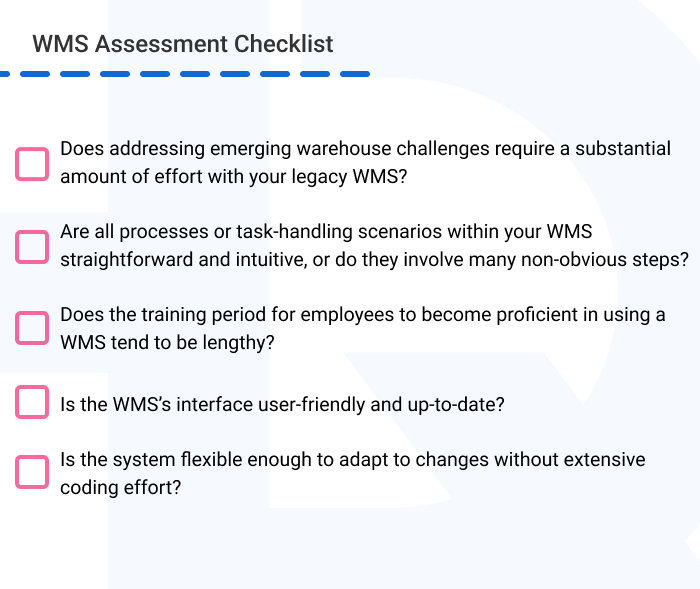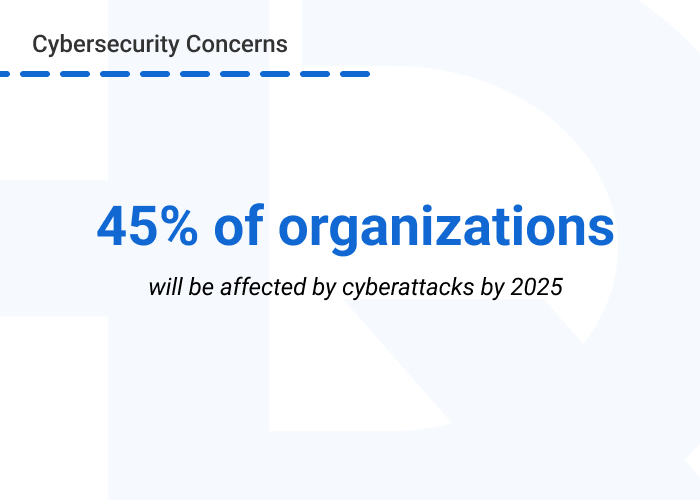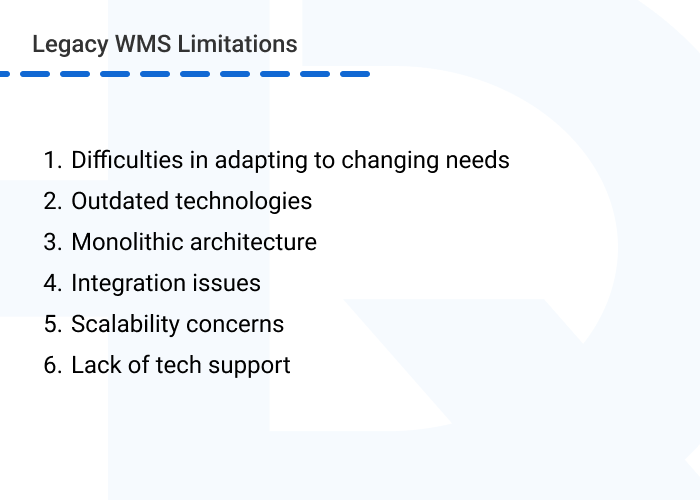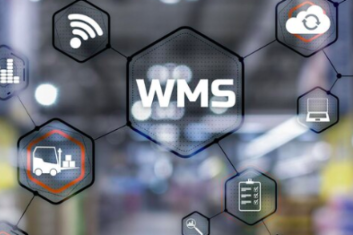Challenges of Sticking with a Legacy WMS
In a time of rapid technology advancement, relying on a legacy warehouse management system (WMS) means reduced business efficiency, unnecessary costs, and an inability to leverage cutting-edge technologies. And that’s not just my opinion. About 90% of companies struggle because of legacy systems and technologies.
Having witnessed the negative impact of outdated software on the operational efficiency of our clients at HQSoftware, in this article, I’ve gathered the facts about common disadvantages associated with a legacy WMS and outlined how WMS upgrades can be the solution.
The Evolving WMS Landscape
When warehouses first embarked on the path of digital enhancement, the primary goals were to provide visibility, standardize operations, and monitor performance. The first warehouse management systems, or even simple Excel docs, successfully dealt with these tasks.
However, the present business landscape demands more. Customer expectations are rapidly growing, and one small mistake can lead to revenue loss. At the same time, businesses aim to save money by not compromising but even enhancing their services.
Sustainability has also become crucial for modern warehouses. Companies are striving to minimize overstocking, optimize packing processes to decrease the number of transportation vehicles needed, make efficient use of warehouse space, and reduce greenhouse gas emissions associated with energy use and transportation.

Achieving these goals requires implementing advanced features and technologies, including demand forecasting, navigation systems, and automated audits, to streamline warehouse operations as much as possible.
Legacy WMSs fall short of meeting these evolving requirements, hindering business growth and causing companies to lose ground in the competitive market. Let’s explore some of the other limitations of an old-school WMS.
Challenges of Sticking with a Legacy WMS
There are several reasons why an outdated WMS can limit warehouse efficiency:
- difficulties in adapting to changing needs;
- outdated technologies;
- monolithic architecture;
- integration issues;
- scalability concerns; and
- lack of tech support.
Let’s look at each point in detail.
Difficulties in adapting to changing needs
When your business shifts priorities or grows, warehouse processes naturally change as well. While it may seem possible to adapt to new demands and find ways to handle new warehouse tasks using your legacy system, it may not be as efficient as initially appears.
To help you quickly assess whether a legacy warehouse management system can still effectively meet your evolving requirements, here’s a short 5-question checklist.
- Does addressing emerging warehouse challenges require a substantial amount of effort with your legacy WMS?
- Are all processes or task-handling scenarios within your WMS straightforward and intuitive, or do they involve many non-obvious steps?
- Does the training period for employees to become proficient in using a WMS tend to be lengthy?
- Is the WMS’s interface user-friendly and up-to-date?
- Is the system flexible enough to adapt to changes without extensive coding effort?

If you answer “No” to two or more questions, your outdated WMS is probably struggling to keep up with your evolving business needs. In this case, we typically advise our clients to consider a new system rather than update a legacy one. Now you may be asking: Why?
Due to outdated technologies and a tightly integrated codebase, each legacy WMS upgrade can be time-consuming, expensive, or even unfeasible. Implementing new features can also lead to reduced system performance. Moreover, altering a legacy system can cause instability, data corruption, or a loss of critical functionality.
As a result, you might end up with a WMS with reduced performance, excessive functionality, and increased expenses, all while still not fully addressing your evolving business needs. Therefore, replacing your legacy system with a more flexible and modern WMS proves to be the more pragmatic choice.
Outdated technologies
A warehouse management system built with legacy technologies can significantly reduce business efficiency due to:
- slow system performance, leading to delays in essential operations such as order processing, inventory tracking, data retrieval, and more;
- limited scalability, resulting in performance bottlenecks and inefficiencies in handling increased inventory, order volume, or the expansion of warehouse facilities;
- time-consuming system updates, which can require many additional resources;
- complex maintenance, with challenges in finding qualified personnel or compatible software to support the system;
- low system reliability, with numerous breakdowns caused by high load.
For organizations with multiple warehouses or those needing to support remote work arrangements, legacy technologies may introduce additional cloud compatibility limitations. Beyond remote access, this can hinder real-time data and analytics for up-to-the-minute inventory tracking, order status updates, and data-driven decision-making.
Moreover, if you need to enhance your system with cutting-edge technologies, for example data analytics or IoT, the capacity of your legacy WMS may not be enough to integrate them.
This was exactly the challenge we faced when working with one of our clients. They needed to implement Machine Learning for customer demand forecasting, while their outdated WMS was already unable to keep the system stable.
So, our team first migrated the legacy WMS to new technologies and only then integrated Machine Learning algorithms for generating forecasts based on historical data. In this way, we significantly enhanced WMS performance and enabled the customer to reduce inventory costs by 15%.
Need to upgrade your legacy WMS? We’re ready to help!HQSoftware has a team of skilled professionals ready to tackle the project. Let’s talk!
Anna Halias
Business Development Manager
Monolithic architecture
Well, monolithic architecture itself isn’t necessarily bad. It offers relative ease and speed during the initial stages of development, which is why many projects opt for this architecture.
However, if you deal with large volumes of data across various warehouses, the monolithic WMS falls short in terms of scalability.
As all modules in a monolithic system are closely related, you can’t scale just one component, only an entire system. Moreover, any changes made in one part of a monolithic app can negatively impact the performance of a whole system, sometimes even leading to system crashes. For the same reason, integrating new features can also become a challenging task.
On the other hand, microservices architecture is considerably more flexible because of its independent modular structure. It allows you to scale specific components when needed, fostering smart resource allocation. You can also enhance system performance by dedicating specific microservices for particular tasks, save your warehouse from downtimes with microservices fault tolerance, and much more.
Integration issues
For comprehensive operation, your WMS can rely on third-party integrations with internal and external systems. When these integrated systems evolve and a WMS doesn’t keep pace, integration issues become nearly inevitable.
Outdated or unsupported software versions, obsolete integration standards, limited API support, and data isolation can create significant integration challenges. This is especially problematic when trying to integrate with modern systems.
By opting for custom WSM development, you can choose any integrations crucial for efficient business operations, such as an enterprise resource planning system, transportation management system, shipping service providers, e-commerce platforms, and more. This tailored approach can help you avoid many of the integration challenges associated with a legacy or off-the-shelf WMS.
Security concerns
Sticking with your WMS’s legacy technology stack can significantly increase cyberattack risk. An outdated WMS usually relies on weaker encryption methods and security protocols that are no longer considered safe, making such systems attractive targets for cybercriminals.
So, if you’re clinging to an old-school WMS, you might unintentionally increase your chances of becoming one of the 45% of organizations estimated to experience a cyberattack by 2025.
Integrating modern security measures can be challenging due to the integration concerns I’ve described in the previous section. When security protocols are mismatched, vulnerabilities can be introduced, so each integration must be carefully considered.

In contrast, an up-to-date WMS can offer the latest data encryption methods, role-based controls, network firewalls to block malicious traffic, and more. In addition, modern security practices are continuous, involving regular threat monitoring and security audits, which enable proactive response to fraudulent activities.
Lack of tech support
When technologies advance, service providers may become reluctant to deal with outdated systems. So, if problems or glitches arise within your WMS, there may be no official channels to seek help or guidance.
Another challenge here is a lack of relevant expertise, as the pool of experts with knowledge of outdated technologies continues to shrink as businesses transition to newer platforms. Even if you’re lucky enough to find relevant developers, their services can be prohibitively expensive, resulting in additional costs on top of the already time-consuming and costly process of modifying a legacy system.
With all said above, I hope you now see why a legacy WMS isn’t a good partner in your aim of remaining competitive in a rapidly changing business landscape.

Now, let’s discover how a new WMS can help you boost business efficiency.
WMS Upgrade Benefits
I previously discussed the main benefits of WMS software in a separate article. In this context, let’s see how a new WMS can beat the outdated one:
- Modern technology stack, which opens up possibilities for smooth third-party integrations, reliable system performance, responsive tech support, and fast systems adjustments.
- Scalability, as modern WMSs, especially custom ones, are designed to scale according to your needs, whether the goal is expansion or optimization.
- Flexibility, as you can more easily customize a WMS to meet specific business needs, ensuring your system remains aligned with evolving requirements.
- Increased warehouse efficiency, thanks to advanced features tailored to your needs, intuitive and user-friendly interfaces, task automation, and reduced manual errors and system downtimes.
- Enhanced security with robust security measures, including encryption, firewalls, and continuous monitoring.
- Remote accessibility, as many new WMSs are cloud-based, allowing for remote access and real-time data updates.
- Savings on labor costs because of task automation, maintenance costs because of reducing the need for extensive modifications, and inventory costs because of warehouse transparency and real-time data updates.
Future-Proofing Your Business by Implementing a Custom WMS
When you decide that you need a WMS upgrade, the next question arises: “Which system to choose: custom or commercial?”
When I asked our clients why they opted for a custom WMS, these were the most common responses:
- we can choose features that are relevant to our needs, avoiding redundant functionality;
- we want to be confident about system security;
- ready-made systems can’t handle our warehouse growth;
- we need unique features and integrations that are very costly to implement in a ready-made WMS;
- we need full control over a WMS.
For the same reasons, I also recommend you choose custom WMS development, especially if you:
- work with numerous warehouses distributed across multiple locations;
- have complex warehouse workflows that require precise coordination and automation;
- have a specific niche or non-standard storage methods;
- operate in a rapidly changing industry;
- seek differentiation from competitors by offering unique features or services that are not available in ready-made WMS solutions.
Implementing a custom WMS is an investment in the future of your business. You can leverage advanced warehouse navigation to streamline order picking, automated warehouse audits for ensuring inventory accuracy, utilize enhanced data analytics and reporting for decision-making and warehouse optimization, and more. All these contribute to enhanced warehouse efficiency while saving your resources.
Conclusion
While legacy systems served their purpose in the past, they’re becoming anchors in a world that’s rapidly sailing ahead. The future belongs to those who can harness emerging technologies and trends to enhance their warehouse operations.
Our clients are already benefiting from WMSs tailored to their business needs. Perhaps it’s time for you to get rid of legacy systems that are holding you back.
At HQSoftware, we’re always ready to help. Our specialists can upgrade your legacy system, migrate it to a modern technology stack, or build a completely new system from scratch. In certain cases, opting for a new WMS may even prove more cost-effective than upgrading an existing one. Send us project requirements and receive a free quote to determine which option is more suitable for you at this time.

Head of Production
To ensure the outstanding quality of HQSoftware’s solutions and services, I took the position of Head of Production and manager of the Quality Assurance department. Turn to me with any questions regarding our tech expertise.
Related Posts
View All
We are open to seeing your business needs and determining the best solution. Complete this form, and receive a free personalized proposal from your dedicated manager.

Sergei Vardomatski
Founder






